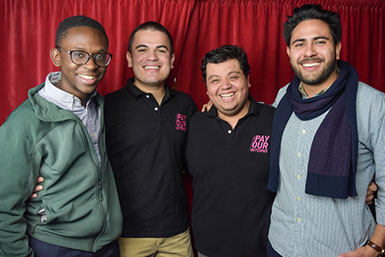
STEM vs STEAM
Why the A Makes a Difference
ABOUT US |
The question on whether or not the arts belong in traditional STEM programs is not one I’m addressing here today. That discussion has been going on for several years now and it’s doing just fine without me.
What I thought might be beneficial is to discuss what we look for in young recruits with a STEM background, given my position as a COO of a tech company. It encourages me that more Hispanic students are entering STEM programs at the university level, however our numbers are still low in the work place and I would see those increase. Diversity and inclusion are critical for growth in all fields. While there are more innovative programs addressing this discrepancy, industry still has a long way to go in our hiring practices.
So, if all things are equal, what makes one candidate stand out above the rest? To answer this question, I pinged several of my hiring managers and recruiters. Their feedback was consistent.
“I want someone who can look at a situation and bypass its current state, which might not be all that great, to see its possibilities.”
“To have someone take one of our products and come up with the next iteration, imagine how it can be used in ways we never dreamed of – that’s unique. That’s the type of person I’m looking for.”
“If all things are equal then I want the person who can turn problem-solving into an art form.”
It would appear that they are all looking for someone with a bit of creativity. There’s multiple definitions on what does being creative mean.The common definition of creativity is: relating to or involving the imagination or original ideas, especially in the production of an artistic work. However, I think the Oxford Dictionary’s definition is more applicable to the world we live in today: the use of imagination or original ideas to create something; inventiveness.
does being creative mean.The common definition of creativity is: relating to or involving the imagination or original ideas, especially in the production of an artistic work. However, I think the Oxford Dictionary’s definition is more applicable to the world we live in today: the use of imagination or original ideas to create something; inventiveness.
So, is designing a car creative or technical? What about building a skyscraper? Creating a video game? For that matter, is creating mapping software a work of art? I think so.
When I look at our engineers and software developers, IT technicians and data analysts, I see teams of people creating three-dimensional maps that grow upwards, breathing with layers of new information and insights. We capture the world in three dimensions. And we’re looking beyond. From autonomous driving to the Internet of Things, we are building the future of location technology by designing great products and collaborating with a global array of strategic partners.
None of this would be possible if we didn’t have people who could dream, create, ideate and implement. But what about the arts? What is the bridge between art and creating technology that will give cities the answers they are looking for? The bridge is Innovation.
Universities, such as my alma mater Lafayette College in Pennsylvania, are widely recognizing that it takes more than excelling in science, technology, engineering and mathematics for students to become effective innovators in the workplace. Educators are looking to build tangible “soft skills” through diverse programs that combine the sciences and the arts while emphasizing innovation and entrepreneurship.
It’s common knowledge in the tech world that scientists and engineers often look towards the arts for inspiration, to help them think creatively. What some do not realize is that today many artists are looking to the world of technology for that same type of creative inspiration.
At HERE, we have combined the two by hiring sketch artists as part of our HERE nXt Innovation program to help us visualize the future. The submission process for employees with new ideas focuses on the written word. Once evaluated for potential, an idea is then turned over to an ideation team which includes the artist. S/he absorbs what’s going on and then drafts graphical representations of the problems to solve, potential solutions or the next iteration of a program.
Why go to such lengths? Because humans are visual creatures. There’s constant debate as to what percentage the human brain absorbs visual information. However, my own experience shows that in delivering presentations to employee town halls or financial briefings to executive boards, visuals make a difference. Quite often audiences need to see what is being discussed.
That still leaves us with questions: is Innovation art? Is art innovation? Does technology derive from one or both? And does creativity make a difference in the hiring of new employees?
While it might not be spelled out in most of our job descriptions, creativity seems to be more prevalent in those candidates who have stepped outside their comfort zones. They have tried new experiences, took non-traditional STEM courses as electives because they were interested in the subject matter, or have hobbies that are off the technological grid.
In short, the answer is yes. Creativity does edge out the competition. When asked does the “A” make a difference I say every form of education has a place. The value the arts contribute to innovation cannot be ignored. To dismiss one form of education for another maybe short changing ourselves, our business, and our future.
Angel Mendez is COO of HERE.
Pay Our Interns
Latino legislative representation has never been higher, with a record 45 members amounting to almost 10% of Congress. But the figure that is rarely discussed is the number of Latino staffers on Capitol Hill. That’s because the figure stands at an abysmal 3%. One of the major causes of this is the proliferation of unpaid internships.
Interning in Congress is a rite of passage for any college student who wants a career in politics. The problem is the majority of them are unpaid. According to Time, an internship in DC, New York City and San Francisco can cost a student up to $6,000 for three months. The price tag we have placed on public service has become a glass ceiling for Latino youth across the country.
Latino youth across the country.
I should know, because when I was 17 I interned for a Latino member of Congress and did not get paid for it. The problem was I couldn’t afford it, so on top of interning 25 hours a week and taking 16 credits, I worked another job so I could pay my bills. I remember walking down the Halls of Congress and seeing how the only people that looked like me were the janitors.
Fast forward to five years later and three unpaid internships under my belt, I decided to launch Pay Our Interns, a 501(c)(3) committed to pushing for more paid internships. I was one of the ”lucky” few able to jump the various hurdles society places on Latinos and other people of color. But it’s not beneficial when only one or two people in the community succeed. We need a pipeline and one that will allow talented Latino youth from across the country who have the drive and the will but need some a little help to make it. 27 percent of Latino children live below the poverty line, compared with 18 percent among all U.S. children. Latinos are being left behind simply because they don’t have $6,000 lying around to intern for free and it’s not right.
I’m proud to say that in one year we have been able to convince several members of Congress to join our initiative and start offering some form of paid internships. We also published the first-ever congressional research report analyzing unpaid internships in Congress titled, “Experience Doesn’t Pay The Bills: Why Paid Internships are a Must in Congress.” Beyond Congress, some of the organizations that we have gotten to start offering paid internships include the Democratic National Committee and the National Organization for Women. All in all, our efforts have led to the creation of 50 paid internships. That translates to 50 more opportunities for low-income and people of color that did not exist before.
As our organization enters year two, we are getting ready to introduce a bill in Congress, and expand our efforts beyond DC. We are driven by the belief that it’s not only morally correct to offer paid internships, but the success and future of our community is tied to Latino millennials and their access to workforce development. In Congress, interns eventually become staffers. Those staffers are the ones who craft legislation and have a major say in the policies that affect our community the most. We as a community must ensure that we are not only pushing for education as a way to success but also providing the tools so that our youth can intern. This also means that we as a community must do better. As a community we must do better and it starts at the top, Latino organizations and Latino politicians should lead by example. The majority of Latino nonprofits and politicians in Congress do not offer paid internships, that needs to change.
Carlos Mark Vera